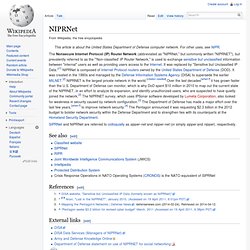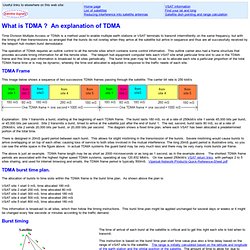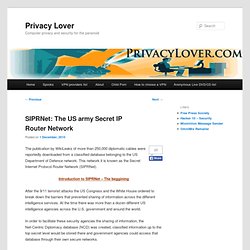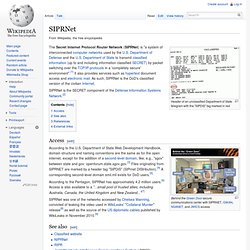

NIPRNet - Wiki. SIPRNet and NIPRNet are referred to colloquially as sipper-net and nipper-net (or simply sipper and nipper), respectively.

See also[edit] References[edit] External links[edit] Explanation of TDMA. Time Division Multiple Access or TDMA is a method used to enable multiple earth stations or VSAT terminals to transmit intermittently on the same frequency, but with the timing of their transmissions so arranged that the bursts do not overlay when they arrive at the satellite but arrive in sequence and thus are all successfully received by the teleport hub modem burst demodulator.

The operation of TDMA requires an outlink control to all the remote sites which contains some control information. This outlink carrier also had a frame structure that provides accurate timing information for all the remote sites. The teleport hub equipment computer tells each VSAT site what particular time slot to use in the TDMA frame and this time plan information is broadcast to all sites periodically. TDMA Frame This image below shows a sequence of two successive TDMA frames passing through the satellite. Explanation: Site 1 transmits a burst, starting at the beginning of each TDMA frame.
Burst timing. Time division multiple access. This article is about the channel access method.

The name "TDMA" is also commonly used in the United States to refer to Digital AMPS, which is an obsolete mobile telephone standard that uses TDMA to control channel access. Time division multiple access (TDMA) is a channel access method for shared medium networks. It allows several users to share the same frequency channel by dividing the signal into different time slots. The users transmit in rapid succession, one after the other, each using its own time slot. This allows multiple stations to share the same transmission medium (e.g. radio frequency channel) while using only a part of its channel capacity. TDMA frame structure showing a data stream divided into frames and those frames divided into time slots. TDMA characteristics[edit] TDMA in mobile phone systems[edit] 2G systems[edit] Most 2G cellular systems, with the notable exception of IS-95, are based on TDMA.
Initial synchronization of a phone requires even more care. See also[edit] SIPR To The Soldier. SIPRNet: The US army Secret IP Router Network. The publication by WikiLeaks of more than 250,000 diplomatic cables were reportedly downloaded from a classified database belonging to the US Department of Defence network.

This network it is known as the Secret Internet Protocol Router Network (SIPRNet). Introduction to SIPRNet – The beggining After the 9/11 terrorist attacks the US Congress and the White House ordered to break down the barriers that prevented sharing of information across the different intelligence services. At the time there was more than a dozen different US intelligence agencies across the U.S. government and around the world. In order to facilitate these security agencies the sharing of information, the Net-Centric Diplomacy database (NCD) was created, classified information up to the top secret level would be stored there and government agencies could access that database through their own secure networks.
Over the past decade, access to SIPRNet has sky rocketed to around half a million people. SIPRNet - Wiki. Header of an unclassified Department of State telegram with the "SIPDIS" tag marked in red The Secret Internet Protocol Router Network (SIPRNet) is "a system of interconnected computer networks used by the U.S.

Department of Defense and the U.S. Department of State to transmit classified information (up to and including information classified SECRET) by packet switching over the TCP/IP protocols in a 'completely secure' environment".[1] It also provides services such as hypertext document access and electronic mail.
As such, SIPRNet is the DoD's classified version of the civilian Internet. SIPRNet is the SECRET component of the Defense Information Systems Network.[2] Access[edit] According to the U.S. According to the Pentagon, SIPRNet has approximately 4.2 million users.[6] Access is also available to a "...small pool of trusted allies, including Australia, Canada, the United Kingdom and New Zealand See also[edit] References[edit]